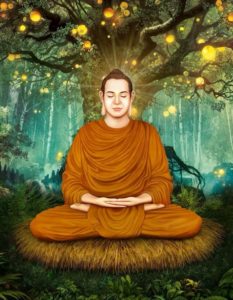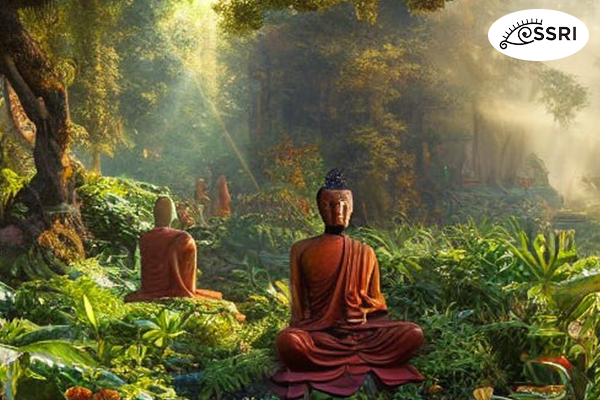Introduction to Buddhism
Buddhism, one of the major world religions, traces its roots back to sixth-century B.C.E. India. Its teachings have since permeated Central and Southeast Asia, extending into China, Korea, and Japan, and now hold followers across the globe.
The Legend of Shakyamuni
According to Buddhist tradition, Shakyamuni, also known as Siddhartha Gautama, emerged as the pivotal figure in Buddhism. Born around 490 B.C.E. into the royal family of the Shakya Clan, he experienced a life far from ordinary. Legend has it that his birth occurred miraculously, with his mother delivering him while standing in a grove of trees.
Despite being surrounded by every comfort and luxury, Shakyamuni’s heart remained restless. His curiosity about life beyond the palace walls led him to embark on four transformative journeys, where he encountered old age, sickness, death and finally, a wandering monk, which ignited a profound spiritual quest within him.
At the age of 29, he renounced his princely life, leaving behind his wife and newborn son, in search of answers to life’s deepest questions. Engaging in rigorous ascetic practices for six years, he realized the futility of extreme self-denial. Opting for a balanced approach, he meditated under a Bodhi tree in Bodh Gaya, achieving enlightenment.
This pivotal moment marked his awakening to true reality and the cessation of desire and ignorance within him, earning him the title of Buddha, the “awakened one.” He shared his insights with his first disciples and embarked on a mission that spanned 45 years, disseminating his teachings across India until his passing at the age of 80.

THE BASIC TENETS OF BUDDHISM
1.The Dharma, Reincarnation, and Karma
Buddhism posits that human liberation from suffering is attainable through meditation and adherence to the teachings of the Buddha, referred to as the Dharma. Symbolized by the wheel, Buddhism illustrates the cycle of life and death, advocating the belief in reincarnation. After death, individuals are believed to be reborn into various forms, influenced by their karma – the consequences of their actions. Positive deeds lead to good karma, elevating one’s rebirth, while negative actions result in bad karma, leading to lower forms of existence. This perpetual cycle of rebirth, or reincarnation, underscores the transient nature of human life.
2. The Four Noble Truths
Integral to the Dharma, the Buddha expounded upon the Four Noble Truths:
- Life is inherently characterized by suffering.
- Suffering arises from craving and attachment.
- Liberation from suffering is achievable.
- There is a path which leads to the end of suffering.
The Four Noble Truths form the cornerstone of Buddhist philosophy, addressing the nature of suffering. According to Buddhism, suffering is intertwined with the impermanence of life. Even moments of happiness are fleeting, as life itself is characterized by suffering. Thus, the ultimate aim of Buddhism is to break free from this cycle of suffering, the cycle of repeated death and rebirth, and attain nirvana.
3.Nirvana
Nirvana represents the pinnacle of Buddhist aspiration – the attainment of enlightenment. It is only through the eradication of greed, hatred, and ignorance within oneself that nirvana can be realized. Signifying the cessation of the cycle of death and rebirth, nirvana is envisioned differently by various Buddhist traditions. Some perceive it as a heavenly realm devoid of suffering, while others view it as a state of mind liberated from anguish. According to Buddhist doctrine, achieving final nirvana marks the end of the cycle of reincarnation and death.
4.How to Achieve Nirvana
Buddhists follow the Middle Way, also known as the Eightfold Path, as the route to nirvana, delineating guidelines for righteous living.
The Eightfold Path comprises three main categories:
Moral Conduct:
- Right Speech: Abstaining from falsehood, malicious speech, and abusive language.
- Right Action: Avoiding stealing, killing, and unchastity.
- Right Livelihood: Earning a living through ethical means, refraining from activities such as killing living beings or engaging in fortune-telling.
Concentration:
- Right Effort: Exerting oneself to prevent evil and promote goodness.
- Right Mindfulness: Cultivating diligent awareness and attentiveness.
- Right Concentration: Attaining pure equanimity and awareness, purging unwholesome thoughts.
Wisdom:
- Right Thought: Cultivating selflessness, universal love, and nonviolence.
- Right Understanding: Achieving a comprehensive understanding of reality, particularly the Four Noble Truths
5.Bodhisattvas
In certain branches of Buddhism, particularly within Chinese Buddhism, aspiring to become a bodhisattva holds greater significance than achieving nirvana alone. A bodhisattva, having attained enlightenment, pledges to postpone entering final nirvana until all sentient beings are liberated from suffering. Opting for rebirth, bodhisattvas dedicate themselves to alleviating the suffering of others and disseminating the teachings of the Buddha. In Chinese Buddhism, bodhisattvas are sometimes revered on par with the Buddha himself. Notably, the female bodhisattva Guanyin gained widespread worship across Buddhist temples in China, embodying compassion as the Chinese Bodhisattva of Compassion.
- INDIA DURING BUDDHA’S LIFETIME – Buddha’s teachings transcended societal hierarchies, emphasizing individual agency over one’s fate. This contrasted sharply with the prevailing beliefs of Buddha’s era, characterized by Brahmanism as the dominant religion. Brahmanism advocated animal sacrifices and offerings to Brahmanic priests for salvation. Furthermore, society was rigidly stratified into castes, dictating marriage and occupation. Buddhism diverged by rejecting social distinctions and claims of superiority based on birth, making its teachings accessible to all. Rejecting animal sacrifices, Buddha underscored the cultivation of compassion for all living beings.
- BUDDHIST TEXTS –Following Buddha’s demise, various schools of Buddhism emerged, each with distinct characteristics. Despite evolving over centuries, Buddhism maintains continuity through seminal texts like the Pali Canon, encompassing the “First Discourse,” and numerous sutras such as the Lotus Sutra, which found popularity in China and Japan. These texts serve as foundational pillars, fostering the continuity and development of the religion.

BUDDHISM IN CHINA
1.History
Legend intertwines the origins of Buddhism with the travels of Laozi, credited as the founder of Daoism, who, according to Chinese folklore, journeyed to India and became known as the Buddha. Although Buddhism originated beyond China’s borders, it found fertile ground in the country, where it was embraced and adapted.
By the second century C.E., Buddhist ideas permeated China, propagated by merchants, traders, and pilgrims. The introduction of concepts such as karma, reincarnation, and monasticism brought new dimensions to Chinese thought. Despite opposition, particularly from Confucian circles, Buddhism flourished, capitalizing on the instability following the collapse of the Han Dynasty (202 B.C.E–220 C.E.).
During the subsequent Northern and Southern Dynasties (317–589 C.E.), Buddhism entrenched itself across all strata of Chinese society. The Tang Dynasty (618–907 C.E.) witnessed a golden age for Buddhism, during which temples amassed vast wealth and influence, enjoying exemptions from taxation. However, resentment among Daoist and Confucian elites led to a government crackdown in 844–45 C.E., resulting in the confiscation of Buddhist assets and the destruction of temples.
Despite periodic persecution, Buddhism continued to shape Chinese spiritual life, fostering a cultural exchange that saw the blending of Buddhist, Daoist, and Confucian ideas. Even during the upheavals of the Cultural Revolution, Buddhism endured suppression but left an indelible mark on Chinese culture, ensuring its enduring legacy.
2. Pure Land and Chan Buddhism
Buddhism underwent significant transformation upon its adoption in China, giving rise to distinctive schools such as Pure Land Buddhism and Chan Buddhism.
Pure Land Buddhism is centered around the concept of enlightened beings creating paradises called “Pure Lands.” Devotion to these buddhas and bodhisattvas is thought to enable rebirth into these blissful realms. The Western Paradise, associated with the Buddha Amitabha, is one such Pure Land that devotees believe can be accessed through dedicated devotion and the recitation of Amitabha’s name, especially at the moment of death.
Chan Buddhism, which originated in the sixth and seventh centuries, places a profound emphasis on meditation as the primary means to enlightenment. Legend attributes its beginnings to the monk Bodhidharma, who reputedly meditated intensely for nine years. In Chan practice, meditation is considered paramount, with a focus on direct experience and realization, rather than reliance on religious rituals or scripture recitations.
3.Tibetan Buddhism
Chan Buddhism, Tibetan Buddhism diverges significantly from its Chinese counterpart, having adopted Indian influences rather than Chinese. In the seventh century, Tibet embraced Buddhism, incorporating aspects of Indian civilization while also retaining indigenous Bon rituals. Notably, Tibetan Buddhism places emphasis on the identification of certain lamas, including the Dalai Lama, through the process of reincarnation. Identified children, often born into influential families, undergo rigorous training to fulfill their roles as lamas, with the Dalai Lamas believed to embody the Bodhisattva of Compassion.
III. THE SPREAD OF BUDDHISM
From its origins in India, Buddhism spread across Asia, reaching countries such as Korea, Japan, Thailand, Myanmar (Burma), Sri Lanka, Cambodia, Laos, and Vietnam. Japan’s Prince Shotoku, aiming to enhance his country’s power and cultural development, embraced Chinese Buddhism during the Tang Dynasty, paving the way for significant cultural exchange between Japan and China. Buddhism demonstrated remarkable flexibility over time, adapting to diverse cultural contexts and maintaining a lasting influence worldwide.
Resources
- Schuhmacher and Woerner, pp. 11–12.
- Ch’en, p. 5.
- Keown, pp. 55–56.
- Ch’en, p. 6.
- Rahula, pp. 48–49.
- Rahula, p. 49.
- Littleton, p. 82.
- Reat, p. 137.
- Reat, p. 147.
- Reat, p. 148.
- Schuhmacher and Woerner, pp. 8–9.
- Reat, p. 220.
- Reat, p. 240.
- Reat, p. 189.




